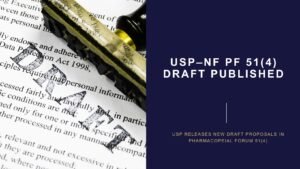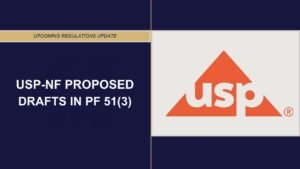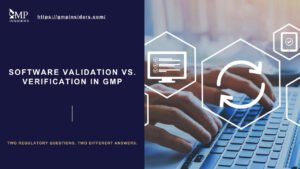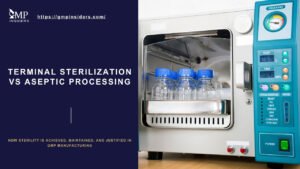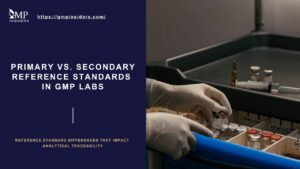USP has released new draft proposals in the Pharmacopeial Forum 51(6). This set of updates includes significant ophthalmic changes (quality tests and a renamed general considerations chapter), focused leachables guidance for OINDP and topical ophthalmics, radiopharmaceutical processing refinements, and a modernized analytical procedures validation chapter aligned to ICH Q2(R2)/Q14 and the analytical lifecycle.
The overall direction continues to emphasize risk-based thinking, lifecycle control, and clearer connections between design, validation, ongoing performance, and GMP decision-making.
Why this matters: These drafts clarify sterility expectations for ophthalmics, move several test elements into a consolidated general considerations chapter, sharpen leachables strategies for high-risk dosage forms (MDIs/DPIs, ophthalmic solutions/ointments), and update analytical procedures validation to explicitly center on fitness for purpose and the reportable result (RR).
Overview Table of USP–NF PF 51(6) Draft Proposals
| Chapter | Type | Focus | GMP Impact |
|---|---|---|---|
| 〈1225〉 Validation of Compendial Analytical Procedures | Revision | Aligns with ICH Q2(R2)/Q14; centers fitness for purpose, reportable result (RR), replication strategy, statistical intervals; ties to 〈1220〉 and new 〈1221〉 | Lifecycle-based validation protocols; acceptance criteria linked to RR; clearer study design/replication logic for decision-making. |
| 〈1771〉 Ophthalmic Products – General Considerations (title updated from Performance Tests) | Revision | Adds sterilization approaches; container–closure evaluation (drop size, resuspendability, leachables/extractables); simulated-use studies; broader performance testing guidance | Stronger design/development and in-use evidence; moves certain tests out of 〈771〉; updates to product development SOPs and study designs. |
| 〈771〉 Ophthalmic Products – Quality Tests | Revision | Clarifies sterility, pH/osmolality, preservatives, UDU, container contents; adds drug–device combo subsection; transfers drop size, resuspendability, L&E, CCI to 〈1771〉 | Quality tests streamlined; sterility emphasis; device interplay recognized; dossier and method sections will need realignment. |
| 〈1664.1〉 Leachables in Orally Inhaled & Nasal Drug Products (OINDP) | Revision | Adds elemental impurities, nitrosamines, more leachable time points; explicit SCT practice (1.5 µg/day) and AET examples (e.g., MDIs) | Tighter lifecycle leachables strategies; stronger E–L correlation; storage/time-point design; higher scrutiny for MDIs. |
| 〈1664.3〉 Leachables in Topical Ophthalmic Drug Products | New | Scope for solutions/suspensions/emulsions/ointments; packaging/process sources; formulation factors (surfactants, oils, preservatives) | Risk-based E&L for ophthalmics; aligns packaging selection and study design to formulation drivers (e.g., BAK, chlorobutanol). |
| 〈825〉 Radiopharmaceuticals – Preparation, Compounding, Dispensing, and Repackaging | Revision | Terminology alignment (e.g., buffer room); immediate-use limits; SRPA expectations; garbing/qualification clarifications; facility/EM updates; BUD/time changes; documentation updates | Operational changes for hot cells/SRPA, qualifications, EM, cleaning/disinfection, and BUD tables; requires SOP/training updates. |
〈1225〉 Validation of Compendial Analytical Procedures
Status: Revision
The revision of 〈1225〉 reflects USP’s intent to fully align the validation of compendial analytical procedures with the analytical lifecycle model described in 〈1220〉 (Analytical Procedure Lifecycle) and ICH Q2(R2)/Q14.
The chapter no longer treats method validation as a standalone exercise but as Stage 2 of the analytical lifecycle, carried out only after the procedure has been designed and shown to be fit for purpose.
The concept of fitness for purpose is now directly tied to the Reportable Result (RR), defined as the final numerical value generated after all analytical steps and calculations, and the value upon which a pass/fail (specification) decision is made.
The revised chapter clarifies that validation must demonstrate that the analytical procedure consistently delivers reportable results with sufficient accuracy and precision to support correct quality decisions and control patient or product risk.
Key Revisions
Key new or modified elements introduced in this draft include:
- Lifecycle Integration and Reportable Result (RR) Focus
- Validation is now explicitly defined as Stage 2 of the analytical lifecycle, following procedure design (〈1220〉) and preceding ongoing performance verification (〈1221〉).
- The reportable result (RR) is established as the central element of validation. All performance characteristics (accuracy, precision, linearity, etc.) must be demonstrated at the RR level rather than at the single measurement or injection level.
- The RR must be clearly defined in the validation protocol.
- Replication Strategy Reframed
- The chapter introduces the concept that the number of replicates used to generate the RR may be reduced “if scientifically justified.”
- However, a reduction in replicates is acceptable only after sources of variability have been minimized (in alignment with ICH Q2(R2)).
- A distinction is made between replication for validation and replication used in routine testing to calculate the RR.
- Acceptance Criteria (AC) Linked to Decision-Making Risk
- Acceptance criteria for accuracy, precision, linearity, range, etc., must now be derived based on:
- The RR, not individual injections or peak areas
- The risk of false pass or false fail decisions
- The chapter requires clear documentation on how ACs support fitness for purpose, specification decisions, and patient/quality risk.
- Statistical Treatment Updated
- The draft introduces guidance on the use of statistical intervals (e.g., confidence or tolerance intervals) when evaluating accuracy and precision.
- Combined assessment of accuracy and precision is now recommended when these characteristics jointly affect reliability of the RR.
- Terminology and Structure Updated to Align with ICH Q2(R2)
- Terminology such as validation characteristics, reportable result, replication strategy, and fitness for purpose are aligned with ICH Q2(R2).
- Cross-references added to 〈1220〉 (procedure design) and 〈1221〉 (ongoing performance verification), which were not present in the current official version.
GMP Impact
Validation protocols should explicitly state RR logic, decision rules, and AC derivation; teams will likely refactor templates to show fitness-for-purpose links and risk-driven replication choices, and to connect validation to ongoing performance per 〈1221〉.
〈1771〉 Ophthalmic Products—General Considerations
Status: Revision (title updated from Performance Tests)
This chapter is renamed from Ophthalmic Products – Performance Tests to Ophthalmic Products – General Considerations to better reflect its broader purpose. It no longer focuses solely on dissolution or drug release testing.
Key Revisions
Key revisions introduced in this draft include:
- Title and Scope Expansion
- Chapter retitled from Performance Tests to General Considerations.
- Scope expanded beyond dissolution to include:
- Sterilization method justification (filtration, moist heat, dry heat)
- Container–closure system (CCS) design and evaluation (dropper systems, materials)
- Leachables/extractables and container–closure integrity (CCI)
- These elements were not previously part of this chapter.
- Transfer of Development-Stage Tests from 〈771〉 to 〈1771〉
The following sections are removed from 〈771〉 and added here:
- Drop size / delivered dose evaluation
- Resuspendability / redispersibility of suspensions
- Leachables and extractables (L&E) for ophthalmic packaging
- Container–closure integrity (CCI)
These are now treated as development-stage requirements rather than QC release tests.
- Simulated-Use / In-Use Performance Studies (New Section)
Manufacturers must perform simulated-use testing to assess product performance under real handling conditions. These studies now cover:
- Delivered-dose uniformity over the labeled in-use period
- Resuspendability after shaking (if suspension)
- Microbial risk during repeated use
- Influence of squeezing force, storage orientation, or applicator performance
- Stability Study Updates
New requirements clarify that stability programs must reflect actual use conditions, including:
- In-use stability at room temperature if stored refrigerated prior to opening
- Evaluation of worst-case conditions when justified, such as inverted storage or temperature excursions
- Additional focus on multi-dose container performance over time
- Dissolution and In Vitro–In Vivo Relevance Repositioned
- Dissolution or drug release testing is no longer default for all ophthalmic products — now only required when a controlled-release mechanism exists.
- Use of in vitro–in vivo correlation (IVIVC) must be justified and is not mandatory unless used to justify dissolution specifications or post-approval changes.
GMP Impact
Expect protocol updates for development and in-use/simulated-use justifications, linked to antimicrobial preservation, device performance, and dose delivery. Several test items relocate here from 〈771〉, so document cross-references and SOP trees will need maintenance.
〈771〉 Ophthalmic Products—Quality Tests
Status: Revision
This chapter has been revised to strengthen clarity on core quality requirements for ophthalmic products, particularly regarding sterility, critical quality attributes (CQAs), and alignment with regulatory expectations for drug–device combination products.
It also formally separates routine quality testing (〈771〉) from developmental and performance testing (now moved to 〈1771〉) to avoid duplication and ensure clearer regulatory expectations.
Several topics previously included in 〈771〉, such as drop size, leachables and extractables (L&E), resuspendability/redispersibility, container–closure integrity (CCI), are transferred to 〈1771〉 because they relate to product development and design qualification rather than finished product QC testing.
Key Revisions
The key revisions include:
- Sterility and Product Classification Clarified
- The chapter explicitly states that all ophthalmic products must be sterile, aligning with 21 CFR §200.50 and reinforcing that sterility is non-negotiable.
- The routes of administration section is revised and visualized to show additional administration pathways (e.g., suprachoroidal, juxtascleral), reflecting modern delivery techniques and regulatory expectations for device-enabled administration.
- Ophthalmic Drug–Device Combination Products
- A new subsection clarifies when an ophthalmic product is considered a drug–device combination, emphasizing:
- Device components (e.g., droppers, multi-dose containers, applicators, implants) must be evaluated for performance and patient safety.
- If device function affects dose delivery or sterility, device-related testing may be required in addition to drug quality tests.
- Device testing elements (drop mechanics, resuspendability, in-use dose delivery consistency) are now moved to 〈1771〉.
- Quality Critical Attributes (QCAs) Updated
- pH testing: Text clarifies acceptable ranges for ophthalmic products and emphasizes the need for justification when outside normal physiological range.
- Osmolality: Updated to describe acceptable osmolality/osmolarity ranges and requires justification if excipients or packaging materials alter tonicity.
- Particle Size Distribution and Suspensions
- The former “Particle Size and Particle Size Distribution” section is simplified and renamed to “Particle Size Distribution.”
- Clarifies expectations for suspension products but shifts resuspendability/redispersibility testing to 〈1771〉 as a development consideration.
- Removed / Transferred to 〈1771〉
- The following topics are no longer in 〈771〉 and are now included under 〈1771〉:
- Drop Size
- Resuspendability / Redispersibility
- Leachables & Extractables
- Container–Closure Integrity (CCI)
- Device performance / simulated-use
These are now treated as product development and design verification activities, not routine batch release criteria.
GMP Impact
Manufacturers should re-map testing responsibilities (what stays in 〈771〉 vs moves to 〈1771〉), reinforce sterility rationales, and ensure dossier/QC method sections reference the correct chapter for device-related impacts.
〈1664.1〉 Assessment of Leachables in Orally Inhaled and Nasal Drug Products
Status: Revision
The chapter modernizes OINDP’s leachables strategy by incorporating elemental impurities, nitrosamine considerations, and additional time points beyond shelf life. It reiterates the two primary leachables sources (process equipment and container–closure).
It provides terminology, storage/time-point tables, and AET calculation examples anchored to the current SCT practice of 1.5 µg/day (with exceptions managed under “special case compounds”).
Key Revisions
Key new or revised elements introduced in this chapter include:
- Inclusion of Nitrosamines and Elemental Impurities
- Nitrosamines are now explicitly listed as potential leachables that require evaluation if there is a chemical pathway or material source (e.g., elastomers, propellants, amines).
- Elemental impurities (metals leaching from valves, canisters, stainless steel, and seals) must now be assessed in accordance with ICH Q3D and USP 〈232〉/〈233〉.
- These impurity classes were not included in the previous version of 〈1664.1〉.
- Updated Safety Threshold Logic (SCT / AET / Special Case Compounds)
- The Safety Concern Threshold (SCT) is now fixed at 1.5 µg/day unless otherwise justified.
- The chapter adds a new category of “special case compounds” — substances such as nitrosamines or highly potent carcinogens, which require thresholds below SCT.
- Defines clearer rules for calculating the Analytical Evaluation Threshold (AET) using SCT, dose, and uncertainty factors.
- Leachables Stability Study Requirements Expanded
- Adds specific storage conditions and time points that must be used for registration leachables studies. Example timepoints now include:
- 25 °C / 60% RH → 3, 6, 12, 18, 24, 36 months
- 30 °C / 65% RH → 3, 6, 12, 18, 24, 36 months
- 40 °C / 75% RH → 3, 6 months
- Older version did not specify time points or require multi-timepoint leachables trending over the full shelf life.
- Revised Dosage Form Risk Ranking
- Introduces formal risk tiers for inhalation and nasal dosage forms.
- Pressurized Metered Dose Inhalers (pMDIs) are identified as highest-risk because of:
- Continuous contact between formulation and container–closure
- Organic propellants increasing solubility of extractables
- Medium-risk: nasal sprays, multidose pumps, DPIs.
- This formal stratification did not exist before.
- Lifecycle-Based Leachables Program Design
- Leachables are now expected to be assessed across the product lifecycle, not only at product approval:
- Development phase (extractables–leachables correlation)
- Registration stability studies
- Post-approval changes to packaging materials, suppliers, or formulation
- This lifecycle language is newly introduced in PF 51(6)
GMP Impact
OINDP programs will need more explicit E–L correlation, earlier nitrosamine/elemental risk screening, and expanded stability leachables time-points; MDIs in particular require a comprehensive component-level AET rationale and correlation.
〈1664.3〉 Assessment of Leachables in Topical Ophthalmic Drug Products
Status: New Chapter
This is a newly proposed chapter in PF 51(6) that provides a dedicated framework for assessing leachables in topical ophthalmic drug products (e.g., solutions, suspensions, emulsions, ointments). These expectations were not included in previous USP–NF texts until now; ophthalmic products relied on general 〈1664〉 and 〈1664.1〉 〉, which primarily focus on parenteral and inhalation dosage forms.
Key Provisions
Key new elements introduced in this chapter include:
- New Scope Specific to Ophthalmic Products
- First USP chapter dedicated to leachables in ophthalmic products.
- Applies to solutions, suspensions, emulsions, gels, ointments, and multi-dose containers.
- Recognizes that ophthalmic packaging materials (LDPE, HDPE bottles, tips, caps, laminates, foil seals) are potential sources of leachables.
- Risk-Based Approach to Ophthalmic Leachables
- Requires manufacturers to conduct a risk assessment considering:
- Formulation composition (aqueous vs oil-based systems)
- Use of surfactants, preservatives (e.g., BAK, chlorobutanol), tonicity agents
- Contact time and surface interaction with container–closure systems
- Introduces the concept that oil-based ointments, emulsions, and preservative-containing eye drops may increase leaching due to higher solvent capacity.
- Packaging and Material-Specific Requirements
- Adds requirements to evaluate all components in direct contact with the product, including:
- Bottle, dropper tip, cap, liner, foil seals, and applicators
- Specifies that single-dose and multi-dose containers must be assessed separately due to differences in preservative use and oxygen exposure.
- Leachables vs Extractables: Explicit Separation for Ophthalmics
- Annex added to clarify:
- Extractables = compounds that can migrate under exaggerated conditions
- Leachables = compounds that actually migrate under real storage/use conditions
- Requires extractables data before leachables studies are designed.
- Integration into Product Lifecycle (Stage-Based Approach)
- Leachables assessment must be addressed during:
- Product development (formulation–packaging compatibility)
- Registration stability studies
- Post-approval changes to packaging or formulation
- Extractables–leachables correlation must be demonstrated where possible.
GMP Impact
Expect tighter links between formulation selection and packaging/E&L design, with justification for ingredient choices that elevate leachables risk. This will drive earlier packaging screening and targeted analytical plans for ophthalmics.
〈825〉 Radiopharmaceuticals—Preparation, Compounding, Dispensing, and Repackaging
Status: Revision
This chapter is revised to align terminology, update sterile processing expectations, refine immediate-use radiopharmaceutical requirements, and clarify facility/environmental controls. Several updates are based on stakeholder feedback and harmonization with 〈795〉 and 〈797〉.
Key Revisions
The key revisions in this chapter include:
- Terminology and Language Updates
- “Buffer area” replaced with “buffer room.”
- “Personnel” replaced with “individuals.”
- “Sterile compounding” replaced with “radiopharmaceutical processing.”
These terminology changes are applied throughout the chapter.
- Immediate-Use Radiopharmaceuticals — New Restrictions
- Intrathecal radiopharmaceuticals are no longer permitted under immediate-use conditions.
- Non–direct infusion generators cannot be processed as immediate-use. These must be stored and eluted only in a Segregated Radiopharmaceutical Processing Area (SRPA) with minimum ISO 8 total airborne particle classification.
- Operators must be trained and qualified in aseptic practices when working in SRPA for generator elution.
- Personnel Qualifications and Aseptic Practices Updated
- In 4.1 Aseptic Qualifications, clarifications were added to gloved fingertip/thumb sampling procedures.
- Reevaluation and requalification requirements updated: If radiopharmaceutical processing is paused for a defined period, requalification is required.
- Ancillary individuals (new term replacing ancillary personnel) — roles clarified for individuals entering classified areas who do not directly handle radiopharmaceuticals.
- Hand hygiene for immediate-use and nonsterile preparations is revised to allow alcohol-based hand rub when handwashing occurs outside classified areas, with conditions.
- Facilities and Engineering Control Changes
New or revised requirements include:
- Permanent line of demarcation is now mandatory in anterooms; tacky mats or tape are no longer acceptable as a demarcation method.
- Smoke studies and environmental monitoring must be repeated whenever equipment is relocated or modifications affect airflow.
- Pressure differential monitoring devices must be verified for accuracy every 12 months.
- For leukocyte labeling areas, minimum pressure differential values are now specified.
- Clarification added for ceiling system sealing and surface cleanability.
- Cleaning and Disinfection Updates
- Frequency of surface cleaning/disinfection updated.
- Table 5 updated to include handwashing sink surfaces in routine disinfection requirements.
- All disinfectants and sporicidal agents used within the PEC must be sterile, except tool handles and holders.
- Beyond-Use Date (BUD) Changes
- In Table 7, “Direct infusion system, one puncture only” BUD changed from 10 to 12 hours.
- Clarified that for radiolabeled blood components, BUD is 6 hours from patient blood collection.
- Radiopharmaceutical preparations may exceed component BUDs if permitted in approved labeling.
- New requirement for multi-dose radiopharmaceuticals containing preservatives to follow revised BUD guidance.
- Documentation Revisions
- Master Formulation Record now must include prescribing information as an example of validated ingredient documentation.
- Section 9.2 renamed to clarify that records apply to all preparations, not just those with minor deviations.
- Dispensing and Generator System Updates
- Direct infusion system expiration extended from 10 to 12 hours after puncture.
- Section 12.3 renamed to Direct Multidose Radiopharmaceutical Infusion Systems.
- New Section 12.4 added: standards for non-direct infusion generator systems (setup, storage, elution, training, garbing, aseptic handling).
- Glossary Additions and Changes
New definitions added for:
- “Low-lint,” “nondirect infusion generator system,” “radiopharmaceutical processing,” “remote manipulation system,” “validation,” and “verification.”
- “Direct infusion system” updated; “low-lint wiper” removed.
GMP Impact
Nuclear pharmacy and clinical settings should revise SOPs for SRPA operations, retrain on garbing/aseptic qualifications, update EM and smoke study triggers, and relabel BUDs where changed. QA should audit demarcation, logs, and documentation against the new text.
Final Thoughts on USP–NF PF 51(6) Draft
The PF 51(6) drafts reflect USP’s continued shift toward lifecycle-based control, in which quality is demonstrated not only at release but also through design, validation, ongoing performance verification, and documented risk-based decision-making.
Across all revised chapters, three themes are consistent:
- Risk-based expectations are now embedded across development, validation, QC, and distribution, whether in analytical replication strategies, ophthalmic design and in-use studies, leachables program design, or radiopharmaceutical handling.
- Clearer separation of responsibilities between development and QC, 〈1771〉 consolidates design-stage ophthalmic testing (drop size, resuspendability, CCS, simulated-use), while 〈771〉 focuses strictly on finished product quality tests.
- Closer regulatory alignment and defensibility: validation now centers on the reportable result (RR), leachables strategies align with SCT/AET logic and nitrosamine risk, and radiopharmaceutical standards are harmonized with 〈795〉/〈797〉 expectations.
Once put into effect, these proposals will require companies to adjust SOPs, validation templates, development protocols, packaging assessments, and documentation structures. Early review and internal impact assessments will help avoid last-minute changes once the chapters become official.
PF 51(6) is currently open for public review and comment. Stakeholders, including manufacturers, laboratories, pharmacies, suppliers, and regulatory professionals, are encouraged to submit feedback to USP during the comment period to help shape the final chapters before adoption.




